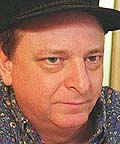 Graphic: A different theory of Aloha Flight 243 Graphic: A different theory of Aloha Flight 243
 Engineer fears repeat of 1988 Aloha jet accident Engineer fears repeat of 1988 Aloha jet accident
 Austin's Web site: www.disastercity.com Austin's Web site: www.disastercity.com
By Michele Kayal
Advertiser Staff Writer
Matt Austin knows a few things about how machines work.
And for him, the official reasoning on Aloha Airlines Flight 243 just didn’t cut it.
 |
| Matt Austin, whose profession was industrial safety, saw it as a duty to look into the Aloha Airlines incident.
Cory Lum • The Honolulu Advertiser |
Toiling through midnights, through mornings, through any spare moment he could find for the past 13 years, the 43-year-old divorced boiler specialist hunkered down in his one-bedroom McCully apartment with more than 4,000 pages of documents, diagrams, photos and theories to figure out what "really" tore the top off the ill-fated Boeing 737.
"That’s what I deal with on a daily basis — things that blow up," Austin said. "Explosion dynamics is one of my fortes."
Now an independent engineering consultant, Austin moved to Honolulu from Fort Worth, Texas, as a kid in 1970 and got his bachelor’s degree in mechanical engineering from the University of Hawai‘i 12 years later. For eight years as a "boiler cop" for state the Department of Labor and Industrial Relations, Austin monitored things that could explode in Hawai‘i — water heaters in schools, air tanks at service stations, the state’s biggest electrical plants.
So learning what happened on Aloha Airlines’ jet named Queen Lili‘uokalani seemed a natural to him. And he saw it as a duty.
"I did it for the same reason I spent eight years being a boiler cop, working for very little pay," he said, "just to make sure nobody died because an air tank blew up in a service station."
An all-consuming interest
Austin became completely absorbed by his research, he says, to the exclusion of all else.
"No family, no kids, no social life," he says. "Just computers."
Once, several years ago, he found himself on a flight to Kaua‘i piloted by Capt. Robert Schornstheimer, the man who was at the controls the day Flight 243 came apart. Austin followed him off the aircraft as he went to get a sandwich in the airport.
"He didn’t say much," Austin says. "I just told him I was working on this different theory of how the plane failed."
Austin said he has never conferred with the lost flight attendant’s family about his theory.
He did contact reporter Gary Stoller — but only after carefully monitoring his work.
"I read his articles for five years before I felt comfortable enough to give him the story," he said, adding that he wanted a journalist who could understand the story and get it the coverage he felt it deserved.
Putting his data online
The photo that initially tripped Austin’s seminal theory can be seen on his Web site — www.disastercity.com — where his major calculations are amassed. He also offers information on Chernobyl, Three Mile Island, the Titanic and other disasters, though he said he is not working on theories surrounding any of those accidents. On the Web site, he decries the "severe self-absorption" and "technological arrogance" of mankind.
That distaste for technological arrogance and an affinity for public information — his parents worked in the Hawai‘i Newspaper Agency composing room for decades and he made money during college loading paper onto HNA presses — kept Austin going through the long nights and the reams of documents. And now, he says, he wants mankind’s latest folly corrected.
"This particular design philosophy (safe decompression) is a stupid design philosophy to save money," Austin said. "And it shouldn’t be allowed."
For the last several days, he says, he has been "burning the midnight oil" to get the Aloha Airlines information onto his Web site so it would be there when his story was published. But burning the midnight oil is nothing new for Austin: "I usually work between 9 p.m. and 3 a.m. — because that’s when the phone doesn’t ring."
[back to top] |

